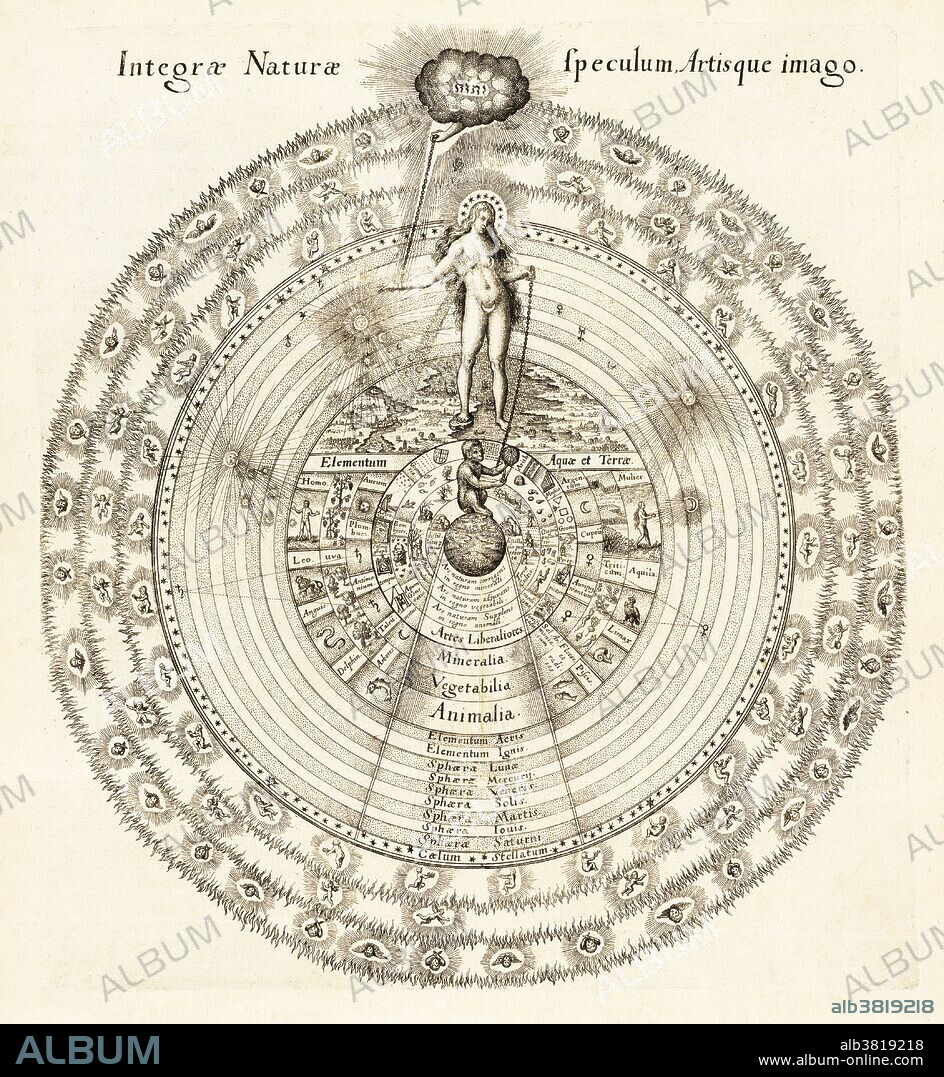alb3819218
Cosmology, Fludd's Integrae Naturae, 1617

|
Añadir a otro lightbox |
|
Añadir a otro lightbox |



¿Ya tienes cuenta? Iniciar sesión
¿No tienes cuenta? Regístrate
Compra esta imagen

Título:
Cosmology, Fludd's Integrae Naturae, 1617
Descripción:
Traducción automática: Integrae Naturae, de Robert Fludd. Durante los siglos XVI y XVII, las nociones de macrocosmos y microcosmos fueron ampliamente aceptadas. Muchas personas creían que los mismos patrones que se encuentran en el cuerpo humano a pequeña escala (microcosmos) se encuentran en el universo natural como un todo (macrocosmos). Aquí, una figura femenina desnuda que representa el alma del mundo está encadenada por la mano derecha a Dios y por la izquierda a un mono que representa al hombre; los símbolos astrológicos y alquímicos llenan los círculos interiores, mientras que la jerarquía de los ángeles forma los círculos exteriores. Robert Fludd, también conocido como Robertus de Fluctibus (1574-1637) fue un médico, astrólogo y místico inglés. Su filosofía se presenta en Utriusque Cosmi, Maioris scilicet et Minoris, metaphysica, physica, atque technica Historia (La historia metafísica, física y técnica de los dos mundos, a saber, el mayor y el menor), publicado en Alemania entre 1617 y 1621.
Integrae Naturae, by Robert Fludd. During the 16th and 17th centuries, notions of macrocosm and microcosm were widely accepted. Many people believed that the same patterns found in the human body on a small scale (microcosm) are found in the natural universe as a whole (macrocosm). Here, a nude female figure representing the world's soul is chained on the right hand to God and on the left to a monkey representing man; astrological and alchemical symbols fill the inner circles, while the hierarchy of angels form outer circles. Robert Fludd, also known as Robertus de Fluctibus (1574-1637) was an English physician, astrologer, and mystic. His philosophy is presented in Utriusque Cosmi, Maioris scilicet et Minoris, metaphysica, physica, atque technica Historia (The metaphysical, physical, and technical history of the two worlds, namely the greater and the lesser), published in Germany between 1617 and 1621.
Crédito:
Album / Science Source / Getty Research Institute
Autorizaciones:
Modelo: No - Propiedad: No
¿Preguntas relacionadas con los derechos?
¿Preguntas relacionadas con los derechos?
Tamaño imagen:
4152 x 4505 px | 53.5 MB
Tamaño impresión:
35.2 x 38.1 cm | 13.8 x 15.0 in (300 dpi)
Palabras clave:
ALQUIMIA • ARTE • ASTROLOGIA • ASTROLOGICO • BLANCO Y NEGRO • CIENCIA • COSMOLOGIA • DESNUDO • DIBUJO • DIOS • FRONTISPICIO • GRABADO • HISTORIA • HISTORICO • HOMBRE • ILUSTRACION • MASCULINO • METAFISICA • MICROCOSMO • MONO (PRIMATES) • MUJER • OBRA DE ARTE • RETRATO DE HOMBRE • SIGLO XVII • SIMBOLISMO • SIMBOLO
 Pinterest
Pinterest Twitter
Twitter Facebook
Facebook Copiar enlace
Copiar enlace Email
Email
